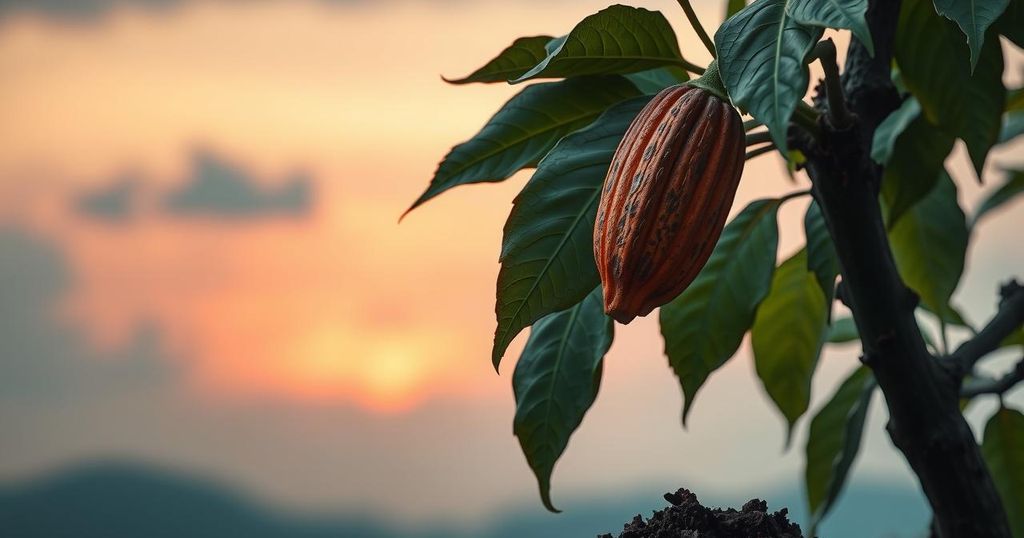Valentine’s Day spending in the U.S. is projected to surpass $27.5 billion in 2024, with chocolate consumption expected to reach 58 million pounds. However, climate change is adversely affecting cocoa production, leading to declining yields and rising prices. Innovative adaptation strategies for farmers and consumer support for sustainable practices are essential to address these challenges.
In the United States, Valentine’s Day expenditures continue to rise, with a forecast of spending exceeding $27.5 billion in 2024. Notably, around 11.2% of these expenses are allocated to chocolate, amounting to an anticipated consumption of approximately 58 million pounds of chocolate during the holiday week. Despite this demand, cocoa production faces critical challenges due to climate change, leading to increased prices. Jessica Fanzo, director of the Food for Humanity Initiative at Columbia Climate School, discusses the detrimental impact of climate change on cacao tree cultivation.
Cacao trees thrive in tropical regions near the equator, primarily in areas such as Southeast Asia, Central and South America, and West Africa, which collectively account for 70% of global cocoa supply. Ideal conditions for cacao production include warm temperatures, consistent humidity, and reliable rainfall. These environmental necessities make cacao trees susceptible to the adverse effects of climate fluctuations and global warming, which threaten their growth and productivity over critical timeframes required for maturation of the cacao pods and the fermentation process.
Climate change significantly disrupts cocoa farming processes due to erratic weather patterns, leading to water stress from droughts or yield reduction from excessive rainfall, which fosters disease and pests. Increasing temperatures exacerbate these issues, resulting in reduced soil moisture and compromised yields. Furthermore, certain regions in West Africa are becoming increasingly arid, posing risks not only to cocoa cultivation but also to overall human health and nutrition. Farmers often resort to migrating to elevated areas to evade extreme heat, although land tenure disputes can complicate this response.
Farmers are exploring various methodologies to adapt to the changing climate. Innovations such as drought-resistant and disease-resistant cocoa varieties are currently being developed in regions like Ghana and Brazil. Additionally, integrating cocoa cultivation with shade trees in agroforestry systems helps regulate temperature and conserve soil moisture. Implementing effective soil and water management practices, such as rainwater harvesting and mulching, can also mitigate drought impacts. Precision agricultural methods and technological tools can empower farmers with vital information for coping with extreme weather conditions and market fluctuations.
Engaging in certification and cooperative programs can offer farmers valuable support, enabling them to transition to climate-resilient cocoa production. These programs, such as Fair Trade and Rainforest Alliance certifications, provide improved pricing structures and financial incentives for sustainable farming practices. It is also crucial to foster community building, access to credit, and technical assistance to facilitate adaptation measures across farming communities, ensuring resilience against climate impacts.
Consumers can play a significant role in promoting sustainable chocolate production by purchasing ethically sourced products that emphasize sustainability certifications. These certifications usually indicate that manufacturers prioritize ethical practices, fair wages for farmers, and environmental stewardship. Comprehensively researching chocolate brands and supporting those that engage in responsible sourcing and agroforestry practices can enhance the impact consumers have on cocoa farming sustainability amidst climate challenges.
The surge in cocoa prices can be attributed to unfavorable yields in major producing countries like Cote D’Ivoire and Ghana, exacerbated by low rainfall and disease outbreaks. Cocoa prices have risen over 300% in the last two years, driven by climate-related events that severely reduced outputs and speculative market behaviors. Consequently, consumers can expect elevated prices for chocolate, thereby influencing their purchases during this Valentine’s Day season.
In summary, climate change poses significant threats to cocoa production, resulting in rising chocolate prices during Valentine’s Day. As conditions for cacao trees deteriorate, farmers must adapt through innovative practices and consumer support. Ethical sourcing and sustainable farming initiatives can mitigate adverse effects, securing better livelihoods for cocoa producers and ensuring continued chocolate availability for consumers. Actions taken now will be essential for the future of sustainable chocolate production amidst climate challenges.
Original Source: news.climate.columbia.edu






